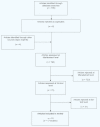Can diabetes prevention programmes be translated effectively into real-world settings and still deliver improved outcomes? A synthesis of evidence
- PMID: 22998334
- PMCID: PMC3555428
- DOI: 10.1111/dme.12018
Can diabetes prevention programmes be translated effectively into real-world settings and still deliver improved outcomes? A synthesis of evidence
Erratum in
- Diabet Med. 2013 May;30(5):632
Abstract
Objective: Randomized trials provide evidence that intensive lifestyle interventions leading to dietary and physical activity change can delay or prevent Type 2 diabetes. Translational studies have assessed the impact of interventions based on, but less intensive than, trial protocols delivered in community settings with high-risk populations. The aim of this review was to synthesize evidence from translational studies of any design to assess the impact of interventions delivered outside large randomized trials.
Methods: Medical and scientific databases were searched using specified inclusion and exclusion criteria. Studies were included that used a tested diabetes preventive study protocol with an adult population at risk from Type 2 diabetes. Included papers were quality assessed and data extracted using recommended methods.
Results: From an initial 793 papers, 19 papers reporting 17 studies were included. Translational studies from a range of settings utilized a variety of methods. All were based on the US Diabetes Prevention Programme protocol or the Finnish Diabetes Prevention Study, with modifications that increased feasibility and access. The main outcome that was reported in all studies was weight change. Weight loss, which occurred in all but one study, was greater in intervention arms than in control subjects. No consistent differences were found in blood glucose or waist circumference.
Conclusions: Translational studies based on the intensive diabetes prevention programmes showed that there is potential for less intensive interventions both to be feasible and to have an impact on future progression to diabetes in at-risk individuals.
© 2012 The Authors. Diabetic Medicine © 2012 Diabetes UK.
References
-
- IDF. Diabetes Atlas. 5th edition. Brussels: International Diabetes Federation; 2011. Available at http://www.idf.org/diabetesatlas Last accessed 26 June 2012.
-
- Tuomilehto J, Lindstrom J, Eriksson JG, Valle T, Hamalainen H, Ilanne-Parikka P, et al. Prevention of type 2 diabetes mellitus by changes in lifestyle among subjects with impaired glucose tolerance. N Engl J Med. 2001;344:1343–1350. - PubMed
-
- Pan XR, Li GW, Hu YH, Wang JX, Yang YW, An ZY, et al. Effects of diet and physical activity in preventing NIDDM in people with impaired glucose tolerance. The Da Qing IGT and diabetes study. Diabetes Care. 1997;20:537–544. - PubMed
Publication types
MeSH terms
LinkOut - more resources
Full Text Sources
Medical


